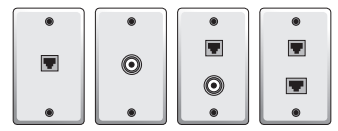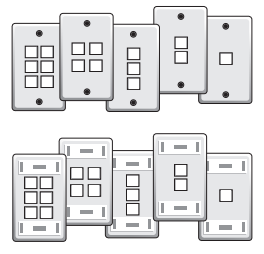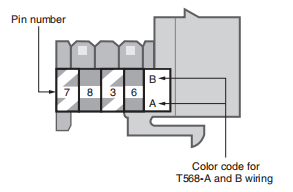Cable & Wire | High quality and excellent service at reasonable prices.
info@zion-communication.com
Author: Will Publish Time: 29-07-2025 Origin: Site
Deciding on wall plates seems easy, but a structured cabling system is not complete without one of its most visible and important components - the wall plate itself, also known as a workstation or station outlet. As the part physically, electrically connects a network device with the cabling infrastructure, they are important factors to consider when cabling either residential or commercial buildings.
A wall plate usually consists of a flat plastic or metal panel that is attached to the wall, floor, ceiling, or cubicle panel. These panels possess one, two, or more jacks through which data, voice, and video devices can get connected. Wall plates come in a wide array of styles, brands, types, and colors to meet aesthetic or organizational needs.

For the design and installation of wall plates, you will need to factor in several things. These include:
Manufacturer System Compatibility: Wall plates and jacks usually act as a total system. If you mix brands, you risk bringing incompatibility problems. With a standard system, you get installation convenience and uniformity.
Wall Plate Location: ANSI/TIA framing standards allow patch cable to have a maximum length of 5 meters (which is ANSI/TIA-568-C.1 for commercial and ANSI/TIA-570-C for residential), which influences the placement decisions of the cable.
Mounting System: You will select the construction stage as well as the type of wall to determine if you will use either outlet boxes, cut-in plates (the remodel version), or surface-mount outlet boxes.
Plate Type: Based on the flexibility of application, the need for future expansion, and cabling types, choice can be made between fixed-design and modular wall plates.
Outlet Boxes
Commercial applications are the main beneficiaries of these plastic or metal boxes fixed to the wall studs. Residential to high-grade data installation can be conducted on a budget with plastic boxes, or metal conduits for the higher end data.
Cut-In Plates (Remodel Mounting)
Remodel boxes and cover-plate brackets are used when retrofitting. The remodel boxes fit to the pre-cut drywall holes and screws or friction tabs, whereas cover-plate brackets (sometimes referred to as cheater brackets) provide a direct wall mounting.
Surface-Mount Outlet Boxes
These are recommended for circumstances that in-wall cable routing is impractical—such as on concrete or brick wall. A surface-mounted raceway houses cables, and the box is stuck to the wall. Although these are portable, readily installed, they sometimes adopt an amateurish look.
Fixed-Design Wall Plates
They are molded into the plate and once mounted, the jacks cannot change. Such plates are normally used in telephone applications. They are very cost-effective and easy to set up, but with limited options. Different configurations include:
Single RJ-11 or RJ-45
Dual RJ-11 or RJ-45
Combinations of RJ-11, RJ-45, coax, or BNC
Note: Most fixed wall plates labeled as “CAT5e” may not actually comply; if it uses screws as the connection terminal, then the wall plate can be easily ruled out.

Modular Wall Plates
These consist of a faceplate with the option for different jack positions. Each jack is bought separately and is able to support different media like:
UTP (Cat5e, Cat6, Cat6A)
Coaxial
Fiber-optic
Benefits of Modular Plates:
Support multiple jacks (up to a 6-jack faceplate in a single-gang plate)
Scalable to adapt to science developments (e.g., IP phones that require an RJ-45 jack, fiber-to-the-desk)
Best for installations that need versatility and scalability
Offers single-, double-, triple-, and quad-gang with the majority configuration being single-gang

Jack Design Considerations
Modular designs positioned jacks in different orientations and included IDC-based punchdown connectors. Straight or 45° angled jacks could be chosen (45° preferred for fiber installations or tight spaces). Wiring schemes provided by TIA (TIA-568A or TIA-568B) must be adhered to between the jacks to ensure proper fit and likely interruptions in service.

These are crucial for both fixed and modular wall plates. Labels could be textual (for example, “LAN,” “Phone”) or icon-based. There are plates that are molded with labels, while others use self-adhesive labels. Labeling them correctly decreases the time required to troubleshoot and prevents confusion with similar products with each other.
Biscuit jacks (surface-mount jacks) are very low-profile boxes (usually three centimeters by two centimeters) often employed in retrofits or modular office furniture. They can be easily adhered to the surface of the material with adhesive tabs and often support a maximum of two jacks. However, conventional biscuit jacks have only Cat-3 compliance of the Ethernet standard, which cannot support the speed of high-speed data used in modern society.
Through having ink much more advanced versions insert modular jacks, which have a rating of Cat5e or higher, which provide better performance in the case of limited space.
Category | Product Name | Description / Use |
Wall Plates | Fixed Wall Plate (Single-Port) | Economical wall plate with built-in jack, typically used for telephone/data. |
Fixed Wall Plate (Dual-Port) | Two built-in ports, may include RJ11, RJ45, or coax combinations. | |
Fixed Wall Plate (Multi-Media Combo) | Combines RJ45, coax, and BNC jacks into one plate. | |
Modular Wall Plate (Single-Gang, 1-4 Ports) | Supports modular jacks; allows flexible port configurations. | |
Modular Wall Plate (Double-Gang, 6+ Ports) | Accommodates multiple jacks; ideal for larger work areas or MDU environments. | |
Angled Modular Wall Plate | Ports angled at 45° to protect bend radius (especially for fiber). | |
Label-Frame Wall Plate | Built-in label window for port identification. | |
Mounting Options | Plastic Wall Box | Used in drywall environments; economical installation base. |
Metal Wall Box | Used in conduit systems or environments with high durability requirements. | |
Cut-In Bracket (Old Work Bracket) | For retrofitting into existing drywall without wall damage. | |
Low-Profile Mounting Bracket | Shallow installation frame, fits tight wall cavities or furniture. | |
Surface Mount Box (Plastic) | Mounted externally on walls, ideal when in-wall cabling is not possible. | |
Raceway with Surface Mount Box | Provides cable routing with termination point in the box. | |
Modular Jacks | UTP Keystone Jack (Cat5e, Cat6, Cat6A) | Termination point for twisted-pair copper cabling; compatible with modular plates. |
STP Shielded Keystone Jack | For shielded cabling installations to reduce EMI/RFI. | |
Fiber Optic Keystone Jack (LC, SC, ST) | Modular adapters for fiber wall plate termination. | |
Coax Keystone Jack (F-Type, BNC) | For TV, video, or RF signal transmission. | |
HDMI/USB Keystone Jack | For multimedia and integrated AV setups. | |
Accessories & Tools | ID Labels / Label Holders | For port identification and TIA-compliant marking. |
Faceplate Screws | Standard screws for wall plate mounting. | |
Punchdown Tool (for IDC Jacks) | Used to terminate wires into keystone jacks. | |
Cable Tester | Verifies continuity and proper termination. | |
Specialty Products | Biscuit Jack (Surface-Mount Mini Jack) | Compact surface-mount box, ideal for retrofits or modular furniture. |
Modular Jack Dust Covers | Protective caps for unused ports. |
While wall plates set out for the purpose of protecting the network cables behind them, they are much more than that. Their shape, type of installation, orientation of jacks, and buckling performance desire for cable standards all impact the efficiency of the structured cabling system. Whether you are considering a fixed choice for a residential install or a modular plate for a scalable commercial setup, you must consider them to avoid problems later down the network life cycle.
Contact us for more information

Will is the Copper Cabling Product Manager at Zion Communication,
specializing in the development and marketing of Ethernet cabling solutions.
With extensive industry experience, he is dedicated to delivering high-performance
and reliable cabling products to OEM/ODM clients worldwide.
will@zion-communication.com
+86 -18268007201
